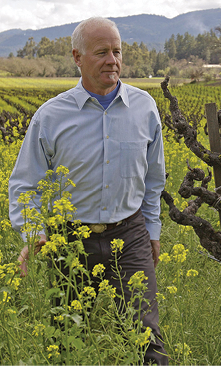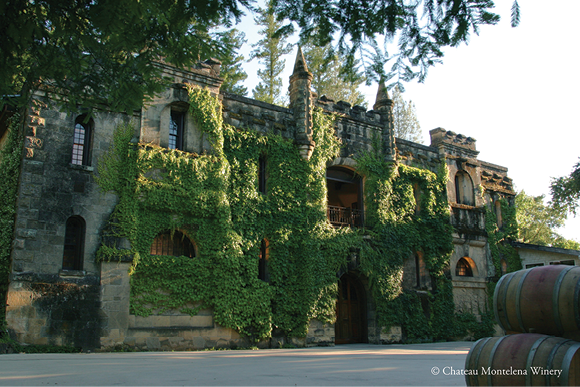


![]()
ONLINE


Bo Barrett
A Trinity of
Farming, Art,
and Science
Editors’ Note
Bo Barrett began his career in the wine industry in the summer of 1972, right after he graduated from high school and his family purchased Chateau Montelena. Since that time, Barrett has been involved in every vintage at Chateau Montelena. Barrett also attended Fresno State University, where he was an honors student in Viticulture and Enology. In 1981, Chateau Montelena’s Winemaker left to pursue other opportunities and Barrett was offered that job by his father, Jim, the winery’s Managing General Partner.
Winery Brief
The wines produced by Chateau Montelena (montelena.com) are handcrafted in the winery’s cellar by their dedicated winemaking team. The wines express the fruit from which they are made and the vintage in which they are grown, with all other elements in balance to complement the fruit. To achieve this goal, they use modern crushing, de-stemming, and pressing equipment to process the grapes as gently as possible. They then use temperature-controlled stainless steel tanks to allow the wines to ferment slowly and evenly. Once fermentation is complete, the wines are transferred to small, French oak barrels to begin the aging process. The winery uses a combination of new barrels along with older, neutral barrels to ensure that the natural flavors of the grapes are not masked by oak. After blending and bottling, the wines receive enough aging time prior to release so that they can be enjoyed right away or laid down to mature for years to come.
What is the history of the winery and how has the brand evolved?
The first wine boom in California happened in the 1880s. There had been a lot of local farmers who were underfunded, and our original founder was somewhat of a wealthy guy. He changed what was state-of-the-art in technology by importing European technology, such as building one of the first stone wineries for temperature control. Early on, our founder was really focused on quality.
When we took over in 1972, it wasn’t much of a stretch to do what he did, which is to be completely focused on excellence and making the best wines we can.

Chateau Montelena Winery
Is the awareness out there about Calistoga as a wine destination?
Absolutely. In the beginning, before they had the AVA system, Calistoga was one of only three districts recognized in the Napa Valley as a wine-growing region, along with St. Helena and Napa.
From the early days of pioneering in Napa Valley, Calistoga has been recognized as an individualistic and special spot.
How can you ensure such consistent quality and what has been the secret to producing such great wine?
It has to do with the experience of the grape-growing teams – the farming side of the equation. If you think about winemaking as a trinity of farming, art, and science, the consistency comes from the farming and science side. Enology is one of the oldest sciences known to man and farming falls under that. When we started in 1972, we hired an extremely experienced Napa Valley winemaker who was already in his ’70s – he had plowed grapes with a mule before World War II.
Today, we can look at the weather and the satellites to get the patterns but, in the old days, you had to use the farmer’s gut instinct, and regardless of how much information you need, instinct and experience will always play a critical component in the consistency. If you’re in a drought year, to get the consistency, you have to adapt for the entire growing season – you can’t be reactive; you have to be proactive and you have to be always a step ahead of the vineyard.
It’s easy for us because we chose the classic European styling so we know what we want to make, which means we’re not chasing the market. When sweet Chardonnay became popular in the 1980s, we didn’t make that. We didn’t follow the pack. You make what you make and people will come.
Have there been technological advances in terms of the winemaking process?
It’s all hand-harvested during the early morning hours, but when we started, it was common that you started picking the grapes at 8 am, and we’ve moved pretty much industry-wide to night, hand harvests.
The workers prefer it, it’s safer and more comfortable, and there is no heat stress. So it seems to have changed a lot in the handling of the fruit.
In the 1970s, winemaking in California came from food-processing. As we see the farm-to-table world we’re working in now, the same thing has happened with grapes over the years.
A lot of people are still working harder but we’re now also working smarter.
Are you known for certain varietals and what range of wines do you provide?
In 1970, we had replanted our Cabernet Sauvignon vineyard, but the goal here was always to make the Estate Cabernet a single-vineyard world-class wine – basically American First Growth.
To fund that, we had to make some white wine to produce revenue because white wines are much quicker to market. However, our second Chardonnay out of the gate was one that achieved much acclaim at the 1976 Paris Tasting.
By 1978, the famous Chardonnay wouldn’t go away, but the Estate Cabernet took off and its first iteration in 1978 checked out as one of the top 10 American First Growth Cabernets being made in North America. That ran until 2008. We still make the Chardonnay and it still has a niche market, but we don’t really expand it. We had a chance to go big, but we stayed focused and true to our game to make the American First Growth Estate Cabernet.
In 2008, the film Bottle Shock came out and Chardonnay became well-known again. Now we’re in the nice position of being recognized as a world-class producer for the historical and modern Chardonnay as well as the Estate Cabernet. We have the happy circumstances of being recognized as leaders both in white and red wines.
How broad is the distribution for the brand?
We are using the first-growth limitation, which is 50,000 cases, and we know it’s the size where you can maintain your consistent quality because it allows the winemaker to remain an artisan, not become an administrator.
We have been happy at that size. We have always remained true to our focus on staying small. The distribution is worldwide and we’re exporting to 38 countries. We make American wines, however, for Americans, and our number-one market by far is the U.S. We use the normal wholesale distribution system and we also do exporting.•